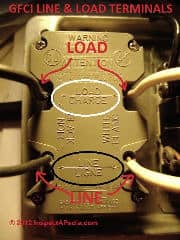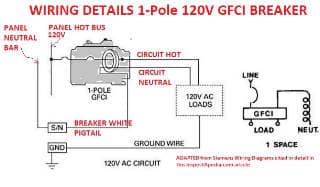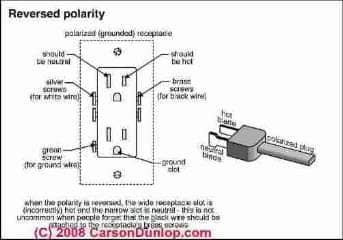 Reversed Polarity at Electrical Receptacles
Reversed Polarity at Electrical Receptacles
What is Reversed Polarity, how do we detect it and why is it dangerous?
- POST a QUESTION or COMMENT about how to install and wire electrical outlets or receptacles in buildings.
Reversed polarity electrical receptacles:
Definition of reversed polarity at an electrical receptacle, its causes, cures, and dangers. What happens if you reverse the hot and neutral wires at an electrical receptacle? We also explain the difference between reversed polarity and reversed LINE - LOAD connections in a building electrical circuit.
This article series describes how to choose, locate, and wire an electrical receptacle in a home. Electrical receptacles (also called electrical outlets or "plugs" or "sockets") are simple devices that are easy to install, but there are details to get right if you want to be safe.
The illustration at page top shows the typical wiring of an electrical outlet or "receptacle", courtesy of Carson Dunlop Associates, A Toronto Home Inspection, Report Writing & Education Firm
InspectAPedia tolerates no conflicts of interest. We have no relationship with advertisers, products, or services discussed at this website.
What is Reversed Polarity at an Electrical Receptacle and Why Is It Unsafe?
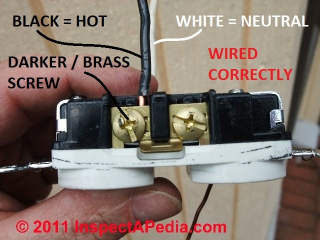
The hot and neutral wires must be connected to the proper terminals on the electrical receptacle or at any other electrical device or circuit.
[Click to enlarge any image]
- The "hot" or "live" black wire (or red wire) should be connected to the brass-colored screw terminal on the
electrical receptacle, usually marked
BLACK or HOT.
The connection shown in our photo (left) is correct. - The "neutral" white wire should be connected to the silver-colored screw terminal on the electrical receptacle, usually marked NEUTRAL or WHITE
Carson Dunlop Associates' sketch points out that the white wire, i.e. the neutral wire, will be connected through the receptacle's internal parts to the wide slot on the receptacle face in order to assure that the neutral wire side of an appliance being plugged-in there is properly connected.
One of our buddies argues "what the heck, it's "alternating current" - the energy is flowing rapidly back and forth at 60 cycles per second on the wires - why would direction or polarity make any difference whatsoever?"
A non-technical answer might be "Why do you think wall plugs and electrical receptacles are 'polarized' or designed with a wide plug blade slot and a narrow plug blade slot (and on many devices a ground connector too) so that the plug will only go into the receptacle one way?" Given that there is extra cost and trouble involved, surely that's not for "no reason"!
Which Wall Plug Blades Connect to Which Receptacle Slots?
Notice that the neutral blade on a wall plug (sketch at left) is the wider blade, plugs into the wider slot in the electrical receptacle, and is intended to connect electrically to the neutral wire inside the receptacle.
The more narrow wall plug blade on a polarized plug is the "hot" blade and is intended to connect electrically to the hot or live terminal in the electrical receptacle.
What Happens When Polarity is Reversed at a Receptacle?
Above we show how easily a wall plug might be plugged into the wrong slots on a gang adapter used to expand the number of devices that can be plugged in at a single location.
This adapter and its use is discussed in more detail
at ELECTRICAL WALL PLUG ADAPTERS - using a wall plug adapter, power strip, surge protector, or electrical spike protection device
Most electrical appliances and devices are designed so that their "on-off" switch interrupts electrical power at the point of entry into the appliance or device circuitry or components.
If you switch the hot and neutral wires that may not quite be the case, and parts of the device will remain energized or potentially energized even when the electrical device switch is OFF.
No electrical current may flow, but it could flow if someone touches the wrong part of the device, or damage may be caused in other circumstances as well, as we describe next.
Watch out: Reversed polarity on an electrical outlet is dangerous. If you accidentally reverse these wires the device you plug in to the receptacle may "work" but it is unsafe and risks a short circuit, shock, or fire.
Even a simple light or floor lamp is less safe with polarity reversed
While some devices such as an incandescent electric light may appear to work properly and safely regardless of which way the lamp's plug is inserted into the wall outlet, virtually all modern electrical appliances, even lamps, use polarized plugs.
In the case of an electric light, the device will "work" properly in either position.
When a lamp or light fixture is connected with proper polarity, the hot wire connects to a contact at the bottom inside center of the bulb socket or screw-in base, and the neutral wire is connected to the shell that contacts the sides of the bulb when it is inserted and screwed into the socket.
But if the lamp is plugged in with its polarity reversed the metal "shell" into which the bulb screws is energized or "hot". Because this component is much easier to touch when changing a light bulb than is the connector in the internal center of the bulb base, a shock hazard is present.
Some appliances and electronic devices may be damaged if polarity is reversed
Some appliances and some electronic equipment may be damaged if left connected to a reversed-polarity electrical circuit.
We disassembled a coffee maker that had burned-up and found that the appliance had been damaged by being left connected to its receptacle with polarity reversed.
The presence of live voltage at the "wrong end" of a circuit or circuit board may cause some devices on the board to remain energized even when the device has been "switched off". A result can be overheating or electrical shock hazards.
Common Causes of Reversed Electrical Polarity on 120V Circuits, Devices, Appliances in Buildings
- The black wire was connected to the silver screw (wrong), and white wire to the brass screw (wrong) where one or more individual electrical receptacles is wired.
In this case you'll also find that the white or neutral ware was connected to the brass colored screw (wrong). - The black and white wires were reversed at a splice in a junction box somewhere in the circuit between the electrical panel and the first receptacle in the string, or between two downstream receptacles in the same circuit.
- The black and white wires were improperly connected in the electrical panel
- In an older electrical circuit it is no longer easy to visually determine which wire is "black" and which is "white". It's easy enough to determine which is the hot wire, using an electrical tester, neon tester, VOM or DMM, by checking for voltage or current flow between an individual wire and ground.
See VOLTS / AMPS MEASUREMENT EQUIP and
also DMM DIGITAL MULTIMETER HOW TO USE - Red hot wire error: Someone did not understand the proper connections for the red wire in a 3-wire or multiwire branch circuit
- Other wiring errors such as short circuits can also produce "false" or apparent "reversed polarity" on a circuit. An example is unanticipated current on a supposedly "off" neutral wire on along a ground wire in an electrical circuit.
Is Reversing Line/Load Connections the Same as Reversed Polarity?
No.
You can reverse LINE and LOAD connections on daisy-chained devices (like the GFCI receptacle shown at left) and the circuit will appear to work properly. However the circuit may not be safe or fully protected.
Line and load electrical wire connections are important to get right on certain electrical devices such as GFCIs and AFCIs. Our photograph (left) illustrates the line and load markings on the back of a GFCI electrical receptacle.
Looking at the side or back of the molded case of this and other electrical devices such as AFCIs, you will see that one pair of terminals will be marked "line" and the other "load".
"Line" terminals
The Line terminals (green arrows in photo at left) on an electrical receptacle are for the incoming hot wire - the terminal marked LINE is connected to the incoming power source or the "hot" wire (typically black or red in insulation color) that connects to the brass colored screw (marked "Black" or "Noir) at the lower left " in our photo.
And the incoming neutral (white) wire from the electrical panel connects to the "Line" and "White" or "Blanc" terminal marked at the lower right in our photo
Load" terminals"
The Load terminals (red arrows near the top of our photo at left) on an electrical receptacle are for the outgoing wires. These wires feed electrical receptacles that are located "downstream"(farther from the electrical panel) from the device.
The outgoing hot or black wire (red arrow, above left in our photo) connects to the terminal marked "Load" or "Charge" and "Black" or "Noir". The outgoing white, neutral wire, connects to the terminal marked "Load" or "Charge" and "White" or "Blanc" in our photograph.
Readers of this article should also
see ELECTRICAL CODE BASICS, ELECTRICAL DEFINITIONS
and also SAFETY for ELECTRICAL INSPECTORS. Our photo at page top is not an example of a proper electrical outlet installation.
This website provides information about a variety of electrical hazards in buildings, with articles focused on the inspection, detection, and reporting of electrical hazards and on proper electrical repair methods for unsafe electrical conditions. Critique and content suggestions are invited. Credit is given to content editors and contributors.
The illustration at page top shows the typical wiring of an electrical outlet or "receptacle", courtesy of Carson Dunlop Associates, A Toronto Home Inspection, Report Writing & Education Firm
Watch out: Electrical components in a building can easily cause an electrical shock, burn, or even death.
Even when a hot line switch is off, one terminal on the switch is still connected to the power source.
Before doing any work on the switch, the power source must be turned off by setting a circuit breaker to OFF or removing a fuse.
See SAFETY for ELECTRICAL INSPECTORS
Reader Comments, Questions & Answers About The Article Above
Below you will find questions and answers previously posted on this page at its page bottom reader comment box.
Reader Q&A - also see RECOMMENDED ARTICLES & FAQs
On 2020-10-26 - by (mod) -
If its a 120VAC circuit it will no longer provide power.
On 2020-10-26 by Anonymous
What will happen if the neutral wire is disconneted from a 2 wire circuit
On 2020-08-11 by Sergio
If I reverse polarity on a lamp with a parallel circuit of lamps, will the "reversed" lamp be slightly dimmer?
On 2020-01-24
by (mod)
- How to fix a receptacle that the GFCI Tester lights up for that reason so how can it be fixed
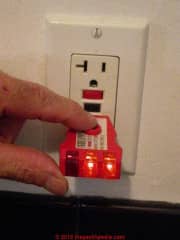 Rusty
Rusty
Thanks for the helpful question on how to fix an electrical receptacle that shows up as defective when using a GFCI tester.
Details about how GFCI testers like yours work and how they should be used are
at GFCI TEST PROCEDURES
You'll note on your GFCI tester that it attempts to detect and indicate (by its light pattern) five different receptacle wiring errors, each of which will then require a different repair:
1. Open ground - this means that the detector did not detect the presence of an electrical ground.
1a. It's possible that there is no ground wire present on the circuit (in which case the wrong type of receptacle has been installed) - such as on older knob and tube circuits. It's permitted to have such receptacles provided the receptacle (outlet) itself is a simple two-prong model that doesn't pretend to offer a ground when none is available. To provide a ground for such a circuity you would have to add a ground wire to the circuit or run an entirely new NMC or armored cable circuit to the receptacle.
See those details at
CONNECTION for 2-WIRE RECEPTACLE CIRCUITS
1.b. It's possible that a ground is present in the electrical box but hasn't been connected to the receptacle ground terminal;
See details at
GROUND WIRE CONNECTIONS at ELECTRICAL OUTLETS
A complete guide to correct wiring for electrical receptacles starts
at ELECTRICAL OUTLET, HOW TO ADD & WIRE
2. Open Neutral: the neutral wire is disconnected, broken, missing. This electrical receptacle cannot be safely used until the broken neutral wire connection is found and repaired. Trace the neutral wire of the circuit to find where it’s been interrupted.
3. Open hot: the hot wire is disconnected or broken: This receptacle will not provide power and thus isn’t usable until the broken hot wire connection is found and repaired. Trace the neutral hot of the circuit to find where it’s been interrupted.
Watch out: this is a particularly dangerous condition as it’s possible that a live hot wire end is floating around somewhere in the circuit - a shock and fire haxard.
4. Hot and Ground Wires have been reversed: this too is a very dangerous mistake - the mis-wired connection may be just at the receptacle or it may be upstream on the circuit to be found and reparied.
Watch out: this is a particularly dangerous condition as well. And unusual in my experience.
5. Hot and Neutral wires are reversed: this wiring error, discussed on this page starting at
REVERSED POLARITY ELECTRICAL DEVICES / CIRCUITS
is perhaps the most-common electrical wiring mistake found in amateur-wired circuits.
At a properly-wired electrical receptacle we expect to find:
Hot wire is the black (or red) wire, connected to the brass-colored “LINE” terminal(s) on the receptacle
Neutral wire is the white (usually) wire connected to the silver-coored “LOAD” side or screws on the receptacle.
Watch out: sometimes the hot and neutral have become reversed upstream from the receptacle where this test result appears. If so the electrician will have to trace the circuit to find the mis-wire connections and correct it.
This error, too, can be unsafe and can damage some electrical equipment as well.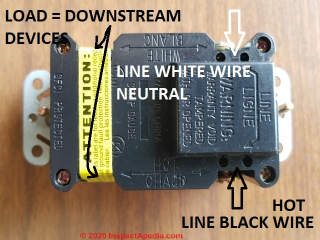
Another error common at GFCI wiring: Reversed LINE & LOAD Wires:
At a GFCI receptacle the incoming hot and neutral should be connected to the LINE terminals
an
the ougoing hot and neutral feeding electrical receptacles downstream from the one being wired - in series or "daisy-chained" - are connected to the LOAD terminals.
Watch out: If these connections are reversed the GFCI and other receptacles will have power but won't work properly in response to a short or current leak at the GFCI so-mis-wired.
Watch out: if you are not trained in proper and safe electrical wiring you should not fool with it as making a mistake can set the building on fire or might shock or kill you or someone else.
GFCI installation and wiring and the illustration shown here are discussed in detail at GFCI DEVICE SELECTION & WIRING
On 2020-01-24
by rusty196455
- How to fix a receptacle that the GFCI Tester lights up for that reason so how can it be fixed
How to fix a receptacle that the GFCI Tester lights up for that reason so how can it be fixed
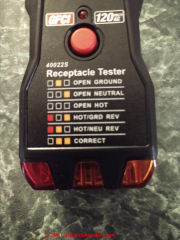
On 2020-01-06 - by (mod) -
Paul
I don't know why cycling your clothes dryer shuts off your furnace, and yeah they ought to be completely independent circuits.
I can speculate that
- they may be on the same circuit and it's overloading
or
- there is a ground fault in the wiring system
On 2020-01-05 1 by Paul R. Frey
Why does my propane furnace (120V ) shut down if I push the heat cycle button on the clothes dryer. No one can figure this out. The furnace technician replaced the furnace control board, pressure switch, and transformer. Furnace still shuts down when we use the clothes dryer.
And I get the five light s blinking code, indicating reverse polarity or bad ground. But that was all checked, and the voltage going in is right, as well as the amps going to the furnace control parts. Why would the clothes dryer have anything to do with the furnace circuitry? Thank You.
On 2018-08-23 - by (mod) -
I've done that, using black tape to mark the hot wire, white tape to mark the neutral wire. But it's a bit unsafe as we don't know where the problem originates nor what else is mis-wired. THe best solution is to follow the circuit backwards from the first point where you see reversed polarity and find the mis-wire. Or start at the electrical panel and follow the circuit forward.
Watch out: if you're not familiar with electrical wiring safety and procedures - a mistake can start a fire or shock or kill someone
On 2018-08-22 by Brian
Whites wire on silver terminals and still have reverse polarity. If I switch the whites to the gold terminals and place a piece of electrical tape on white wire indicating hot wire the tester shows open ground now. Stumped. Guesing switched somewhere in junction box. New home owner
...
Continue reading at ROUTING, SECURING & PROTECTING ELECTRICAL WIRES or select a topic from the closely-related articles below, or see the complete ARTICLE INDEX.
Or see REVERSED POLARITY ELECTRICAL OUTLET FAQs - questions & answers posted originally at this article
Or see these
Recommended Articles
- ELECTRICAL OUTLET, HOW TO ADD & WIRE - home
- BACK-WIRED ELECTRICAL DEVICES
- 2-WIRE RECEPTACLE CONNECTIONS
- ELECTRICAL BOX TYPES
- ELECTRICAL DUPLEX RECEPTACLE WIRING
- ELECTRICAL OUTLET, HOW TO ADD in OLDER HOME
- ELECTRICAL RECEPTACLE ARC PITTING
- ELECTRICAL RECEPTACLES for 30A 240VAC CIRCUITS
- ELECTRICAL WIRE CLEARANCE FROM DUCTS & PIPES
- ELECTRICAL RECEPTACLE CONNECTION DETAILS
- ELECTRICAL RECEPTACLE COUNTERTOP SPACING
- ELECTRICAL RECEPTACLE COVER PLATES
- ELECTRICAL RECEPTACLE HEIGHT & CLEARANCES
- ELECTRICAL RECEPTACLE LOCATIONS
- ELECTRICAL RECEPTACLE TYPES
- ELECTRICAL RECEPTACLE WIRING SERIES vs PARALLEL
- GROUND WIRE CONNECTIONS
- MULTI-WIRE CIRCUITS
- NAIL STOPS to PROTECT WIRES
- NUMBER of WIRE CONDUCTORS
- OLD WORK ELECTRICAL BOXES for RETROFIT
- REVERSED POLARITY ELECTRICAL DEVICES / CIRCUITS
- ROUTING, Securing & Protecting Electrical Wires
- SIZE of WIRE REQUIRED for ELECTRICAL RECEPTACLES
- SPLICING ELECTRICAL WIRES
- STRIPPING ELECTRICAL WIRES
- ELECTRICAL WALL PLUG WIRING ID & CONNECTIONS
- ELECTRICAL WALL PLUG ADAPTERS - using a wall plug adapter, power strip, surge protector, or electrical spike protection device
- ROUTING, SECURING & PROTECTING ELECTRICAL WIRES
Suggested citation for this web page
REVERSED POLARITY ELECTRICAL DEVICES / CIRCUITS at InspectApedia.com - online encyclopedia of building & environmental inspection, testing, diagnosis, repair, & problem prevention advice.
Or see this
INDEX to RELATED ARTICLES: ARTICLE INDEX to ELECTRICAL INSPECTION & TESTING
Or use the SEARCH BOX found below to Ask a Question or Search InspectApedia
Ask a Question or Search InspectApedia
Questions & answers or comments about how to install and wire electrical outlets or receptacles in buildings.
Try the search box just below, or if you prefer, post a question or comment in the Comments box below and we will respond promptly.
Search the InspectApedia website
Note: appearance of your Comment below may be delayed: if your comment contains an image, photograph, web link, or text that looks to the software as if it might be a web link, your posting will appear after it has been approved by a moderator. Apologies for the delay.
Only one image can be added per comment but you can post as many comments, and therefore images, as you like.
You will not receive a notification when a response to your question has been posted.
Please bookmark this page to make it easy for you to check back for our response.
Our Comment Box is provided by Countable Web Productions countable.ca
Citations & References
In addition to any citations in the article above, a full list is available on request.
- Timothy Hemm has provided photographs of various electrical defects used at the InspectAPedia TM Website. Mr. Hemm is a professional electrical inspector in Yucala, CA.
- Mark Cramer Inspection Services Mark Cramer, Tampa Florida, Mr. Cramer is a past president of ASHI, the American Society of Home Inspectors and is a Florida home inspector and home inspection educator. Mr. Cramer serves on the ASHI Home Inspection Standards. Contact Mark Cramer at: 727-595-4211 mark@BestTampaInspector.com
- [3] NFPA - the National Fire Protection Association can be found online at www.nfpa.org
- [4] The NEC National Electrical Code (ISBN 978-0877657903) - NFPA might provide Online Access but you'll need to sign in as a professional or as a visitor)
- US NEC Free Access: See up.codes at this link: https://up.codes/code/nfpa-70-national-electrical-code-2020
- "Electrical System Inspection Basics," Richard C. Wolcott, ASHI 8th Annual Education Conference, Boston 1985.
- "Simplified Electrical Wiring," Sears, Roebuck and Co., 15705 (F5428) Rev. 4-77 1977 [Lots of sketches of older-type service panels.]
- "How to plan and install electric wiring for homes, farms, garages, shops," Montgomery Ward Co., 83-850.
- "Home Wiring Inspection," Roswell W. Ard, Rodale's New Shelter, July/August, 1985 p. 35-40.
- Our recommended books about building & mechanical systems design, inspection, problem diagnosis, and repair, and about indoor environment and IAQ testing, diagnosis, and cleanup are at the InspectAPedia Bookstore. Also see our Book Reviews - InspectAPedia.
- In addition to citations & references found in this article, see the research citations given at the end of the related articles found at our suggested
CONTINUE READING or RECOMMENDED ARTICLES.
- Carson, Dunlop & Associates Ltd., 120 Carlton Street Suite 407, Toronto ON M5A 4K2. Tel: (416) 964-9415 1-800-268-7070 Email: info@carsondunlop.com. Alan Carson is a past president of ASHI, the American Society of Home Inspectors.
Thanks to Alan Carson and Bob Dunlop, for permission for InspectAPedia to use text excerpts from The HOME REFERENCE BOOK - the Encyclopedia of Homes and to use illustrations from The ILLUSTRATED HOME .
Carson Dunlop Associates provides extensive home inspection education and report writing material. In gratitude we provide links to tsome Carson Dunlop Associates products and services.



